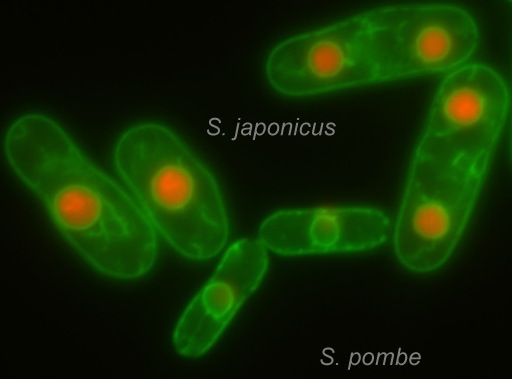A
wonderful resource on working with Schizosaccharomyces
pombe, PomBase
PombeWeb, run by Susan Forsburg
Schizosaccharomyces japonicus page on EnsemblFungi
Hironori
Niki, who together with his lab developed genetic tools for
working with Schizosaccharomyces japonicus, maintains this
useful page
Below is a very detailed protocol for S. japonicus transformation, based on Niki lab protocol published in PMID 20737410:
S. japonicus
transformation
Materials:
YE
Media
Ice-cold
water (distilled, autoclaved)
2M
sorbitol (filter sterilised)
1M
sorbitol (Dilute above 2M sorbitol with ddH2O before use)
1M
DTT (fresh or from -25°C stock)
Electroporation
cuvettes
Electroporator
Selective
plates (e.g. minus ura, plus G418, etc)
1)
Inoculate cells overnight so that they are ready for
the next day in YE media.
2)
The next day, check OD of grown cells (ideal OD is
0.2-0.4). Use ~50ml per transformation.
3)
Spin down cells at 3000 rpm for 3 mins in 50ml
falcon.
4)
Wash with 50ml ice-cold water and spin down, discard
supernatant.
5)
Repeat washes twice with ice cold water.
6)
Resuspend cells in 5ml ice-cold 1M sorbitol and add
250ul of fresh 1M DTT.
7)
Incubate at 30 °C for 15 mins without shaking (just
place in 30°C incubator)
8)
Spin down at 3000rpm, 3 mins and discard supernatant.
9)
Wash with 1ml 1M sorbitol, transfer cells to Eppi
tube, spin down again to remove excess liquid.
10)
In the meantime prepare transforming DNA (see footnote*). Use
A LOT - we typically use ~5 micrograms if transforming with PCR
products and at least ~1.5
micrograms
when transforming with a linearized plasmid.
We resuspend the DNA in 50ul of ddH2O after purification from
column and then add 50ul of 2M Sorbitol so that the final
concentration of Sorbitol is 1M and final volume is 100ul. Add
1ul of sonicated salmon sperm DNA.
11)
Take the prepared DNA (final volume should be 100ul) and
resuspend the cells with it. Incubate in Epp tubes on ice for
30 mins. Remember to chill the cuvettes on ice in the
meantime.
12)
Set electroporator at 2.30kV (see
footnote**). Transfer the cells into the cuvettes,
dry the cuvettes and place in holder. Pulse.
13)
Add 1ml of 1M ice cold sorbitol to the cuvettes.
14)
Prepare 50ml Falcons with 8ml of YES per transformation and
add contents of cuvettes into each tube.
15)
Loosely attach lid with tape.
16) Allow cells to recover overnight at 24°C, shaking (see footnote***)
17) Next day, spin down cells and plate onto 3 selective plates and wait 2-3 days for colony formation (see footnote****).
--------------------------------
Footnotes
*In our hands, plasmid-based targeting gives less false-positive clones at the genotyping stage.
**As
far as we know, the Niki lab uses 2.3KV, 200ohms, 25uF setting
for electroporation. Our lab has an electroporator from Biorad
(http://www.bio-rad.com/en-uk/product/micropulser-electroporator)
that works well at 2.3KV for S.
japonicus. We use 0.2 cm gap width cuvettes.
***Re:
an overnight recovery step. We usually transform cells late in
the afternoon - so that cells are not starved - before plating
them on selection plates. Also, try plating cells at different
densities to prevent over-crowding.
****S.
japonicus colonies do poorly post
transformation at 30°C
on G418 selective plates . We usually keep them at 24°C
until transformants appear. However, Nat (Nourseothricin)-resistant
clones do not have this issue.
Copyright © 2016 by Snezhana Oliferenko
